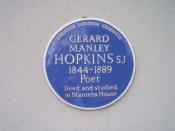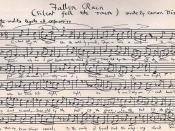'Henry Purcell' by Gerard Manley Hopkins is a sonnet. This is so, as it begins with two quatrains, which describe the musician from whom the poem takes its name, followed by a sestet that takes a closer look at the music that he (Henry Purcell) created. However, a sonnet is usually defined as fourteen lines written in iambic pentameter, and the poem 'Henry Purcell' has six iambic feet per line, and as a result it is a sonnet in Alexandrines. A poem such as this usually includes a caesura, and this is no exception, with the caesura coming in line seven between 'feature' and 'finds'. It does not have a readily recognisable rhyme scheme, but makes use of sprung rhythm in a number of instances.
There are a great number of poetic devices that Hopkins uses throughout this poem. Alliteration is perhaps the most widely used of these, and if the poem were to be rewritten in prose form the effect of this would be lost.
Other similar devices that would disappear if the poem were to be written out in prose form would be the use of archaic language (and other unusual vocabulary), repetition, parallelism, run-on lines, syntax and imagery. These aspects are discussed as they appear in the poem while this essay progresses.
The first line of the poem introduces two of these elements. 'Have fair fallen, O fair, fair have fallen' includes much repetition and alliteration, which we see permeating the poem throughout. Alliteration of the fricative 'f' in this sentence creates a quiet, reflective and ponderous atmosphere that continues over the two quatrains, and into the two three-line stanzas. There is also a great deal of repetition in this first line. The word 'fair' is repeated, as is the entire phrase 'Have fair fallen' in a...


